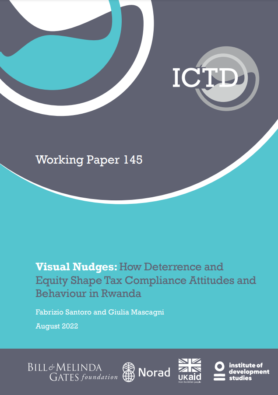Working Paper 145
The empirical evidence on the drivers of compliance is expanding quickly, but there is less evidence from low-income countries. Mass-media communication channels are a cheap option that budget-constrained revenue administrations can use to communicate with taxpayers. However, very little is known about the effectiveness of such tools in improving compliance. This paper starts to address this gap by testing the impact of two short animated videos on tax matters – one focusing on deterrence and the other on equity – that were used in a survey experiment. Using a unique dataset of survey and administrative data from Rwandan taxpayers, we are able to measure the impact on compliance perceptions and behaviour. We document two significant results. First, both videos are effective in improving perceptions around enforcement and equity. Second, only the deterrence video translates into more tax being remitted – the equity appeal fails to raise more revenue. We investigate the mechanisms behind this response, and show that prior behaviour of taxpayers might explain the different responses to our deterrence and equity treatments. Our intervention is highly cost-effective and easily scalable.
